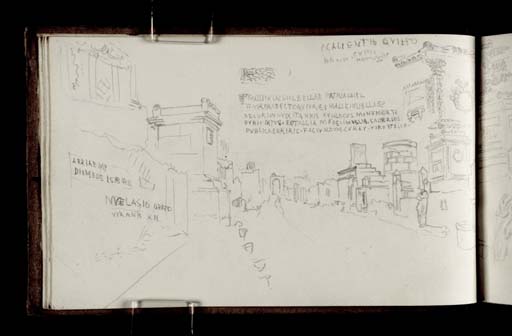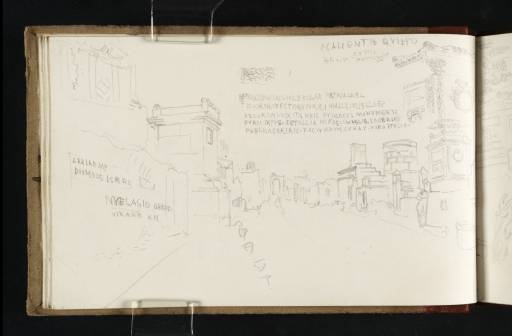Joseph Mallord William Turner Via dei Sepolcri, Pompeii, Looking towards the Porta Ercolano; Also Details and Inscriptions from Some of the Tombs 1819
Image 1 of 2
-
 Joseph Mallord William Turner, Via dei Sepolcri, Pompeii, Looking towards the Porta Ercolano; Also Details and Inscriptions from Some of the Tombs 1819
Joseph Mallord William Turner, Via dei Sepolcri, Pompeii, Looking towards the Porta Ercolano; Also Details and Inscriptions from Some of the Tombs 1819 -
 Joseph Mallord William Turner, Via dei Sepolcri, Pompeii, Looking towards the Porta Ercolano; Also Details and Inscriptions from Some of the Tombs 1819 (Enhanced image)Enhanced image
Joseph Mallord William Turner, Via dei Sepolcri, Pompeii, Looking towards the Porta Ercolano; Also Details and Inscriptions from Some of the Tombs 1819 (Enhanced image)Enhanced image
Joseph Mallord William Turner,
Via dei Sepolcri, Pompeii, Looking towards the Porta Ercolano; Also Details and Inscriptions from Some of the Tombs
1819
Joseph Mallord William Turner 1775–1851
Folio 5 Verso:
Via dei Sepolcri, Pompeii, Looking towards the Porta Ercolano; Also Details and Inscriptions from Some of the Tombs 1819
D15747
Turner Bequest CLXXXV 5 a
Turner Bequest CLXXXV 5 a
Pencil on white wove paper, 113 x 189 mm
Inscribed by the artist in pencil with Latin inscriptions, see main catalogue entry
Accepted by the nation as part of the Turner Bequest 1856
References
1909
A.J. Finberg, A Complete Inventory of the Drawings of the Turner Bequest, London 1909, vol.I, p.547, as ‘Do. [The street of tombs]’.
1984
Cecilia Powell, ‘Turner on Classic Ground: His Visits to Central and Southern Italy and Related Paintings and Drawings’, unpublished Ph.D thesis, Courtauld Institute of Art, University of London 1984, pp.186 note 74, 186–7 note 76, 491 note 32, reproduced pl.108, as ‘Sketches of the Street of the Tombs, Pompeii’.
1987
Cecilia Powell, Turner in the South: Rome, Naples, Florence, New Haven and London 1987, pp.79 note 25, [82] note 60, reproduced pl.81, as ‘Pompeii: the Street of the Tombs’.
Turner began his exploration of the ancient archeological site of Pompeii in the Via dei Sepolcri (Street of the Tombs), the former main road to Herculaneum and Rome. This sketch depicts the view looking east towards the city walls and the Porta Ercolano (Herculaneum Gate), just visible at the vanishing point of the composition. Flanking either side of the road are a number of the tombs of wealthy inhabitants which lined the approach to the city, part of which spills over onto the opposite sheet of the double-page spread, see folio 6 (D15748). During the early nineteenth century this was one of the most impressive and fully excavated sections of the ruins, and consequently it was a popular subject for topographical artists. Compare, for example, James Hakewill’s 1816 drawing, ‘Entrance of Pompeii from Rome’ (British School at Rome Library),1 and an engraving dating from 1817 by Charles Heath, ‘Pompeii. View up the Street of the Tombs’, which later appeared in Sir William Gell’s famous publication, Pompeiana: The Topography, Edifices and Ornaments of Pompeii.2
As well as depicting the relative positions of the individual monuments, Turner has made more detailed drawings of some of the more ornate sepulchres, and transcribed a few of the Latin dedications. The inscription on the far left-hand side, ‘ARRIAE.M.F | DIOMEDES.L.SIBISVIS’, reveals that the artist was standing opposite the entrance to the so-called Villa of Diomedes, beneath the tomb of Marcus Arrius Diomedes. The tomb itself can be seen in folio 5 (D15746). Below this is a second piece of text, ‘NVELASIO GRATO | VIXANN XII’, which identifies the structure above as the tomb of N. Velasius Gratus, whilst to the immediate right is the tomb of Lucius Libella and his son. The artist has made a study of the ornamental moulding from the cornice of the latter, as well as recording the full inscription from the front:
M.ALLEIO.LVCCIO.LIBELLAE. PATRI.AEDILI | IIVIR.PRAEFECTO.QVINO.ET.M.ALLEIO. LIBELLAE.F | DECVRIONI.VIXIT.ANNIS.XVII.LOCVS.MONVMENTI | PVBLICE.DATVS.EST.ALLEIA.M.F.DECIMILLA.SACERDOS | PVBLICA.CER ERIS.FACEINDVM.CVRAVIT.VIRO.ET.FILIO
[To Marcus Alleius Luccius Libella, the father, aedile, duumvir, quinquennial prefect; and to M. Alleius Libella, his son, decurion, aged seventeen years. The site of this monument has been given by the public. Alleia Decimilla, daughter of Marcus, public priestess of Ceres, erected this monument to her husband and son’.]3
[To Marcus Alleius Luccius Libella, the father, aedile, duumvir, quinquennial prefect; and to M. Alleius Libella, his son, decurion, aged seventeen years. The site of this monument has been given by the public. Alleia Decimilla, daughter of Marcus, public priestess of Ceres, erected this monument to her husband and son’.]3
The three tombs visible on the opposite side of the road (right-hand side) represent, from left to right, the Tomb of Scaurus, a circular mausoleum belonging to an unknown occupant, and the Tomb of Calventius Quietus. Turner has made a detailed study of the latter in the top right-hand corner and has also transcribed part of the Latin dedication.4 The full text reads:
C. CALVENTIO.QVIETO | AVGVSTALI | HVIC.OB MVNIFICENT.DECRIONVM | DECRETO.ET.POPVLI.CONSESVBISELLII | HONOR.DATVS.EST’
[To C. Calventius Quietus, Augustal; to him on account of his munificence, by a decree of the decurions, and by consent of the people the honour of the bisellium was granted].5
[To C. Calventius Quietus, Augustal; to him on account of his munificence, by a decree of the decurions, and by consent of the people the honour of the bisellium was granted].5
Further sketches of the Via dei Sepolcri can be found on folios 5, 6–10 (D15746, D15748–D15755). For a general discussion of Turner’s visit to Pompeii see the introduction to the sketchbook.
Nicola Moorby
September 2010
See Tony Cubberley and Luke Herrmann, Twilight of the Grand Tour: A catalogue of the drawings by James Hakewill in the British School at Rome Library, Rome 1992, no.5.55, p.286, reproduced.
Sir William Gell and Joseph Gandy, Pompeiana: The Topography, Edifices, and Ornaments of Pompeii, Second edition, London 1824, vol.I, pl.3, between pp.114–15. See also engravings after 1817 and 1818 drawings by Major Cockburn, ‘General View of the Street of Tombs’ and ‘View up the Street of Tombs, Looking to the Gates’, in Pompeii, Illustrated with Picturesque Views, Engraved by W.B. Cooke, from the Original Drawings of Liet. Col. Cockburn, of the Royal Artillery, vol.II, London 1827, pls.44 and 45, between pp.28–9.
How to cite
Nicola Moorby, ‘Via dei Sepolcri, Pompeii, Looking towards the Porta Ercolano; Also Details and Inscriptions from Some of the Tombs 1819 by Joseph Mallord William Turner’, catalogue entry, September 2010, in David Blayney Brown (ed.), J.M.W. Turner: Sketchbooks, Drawings and Watercolours, Tate Research Publication, December 2012, https://www

